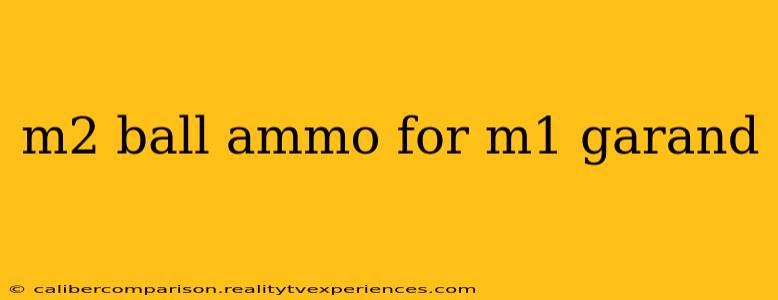The M1 Garand, a legendary American semi-automatic rifle, played a pivotal role in World War II and beyond. Understanding its ammunition, particularly the ubiquitous M2 Ball cartridge, is crucial for anyone interested in its history, operation, or collecting. This guide delves into the specifics of M2 Ball ammo, its characteristics, and its significance in the context of the M1 Garand.
Understanding M1 Garand Ammunition: The .30-06 Springfield Cartridge
Before diving into the specifics of M2 Ball, it's important to understand the cartridge itself: the .30-06 Springfield. This powerful, full-powered rifle cartridge was adopted by the United States Army in 1906 and served as the standard military cartridge for decades. Its widespread use made it a readily available and cost-effective choice for the M1 Garand. The .30-06 Springfield's high-velocity, full-metal-jacket bullet provided effective range and stopping power, making it ideal for battlefield conditions.
M2 Ball: The Workhorse Cartridge
The M2 Ball cartridge is the most common type of .30-06 Springfield ammunition used with the M1 Garand. The "Ball" designation signifies its purpose as a general-purpose round, suitable for a wide range of engagements. Here's a breakdown of its key features:
- Caliber: .30-06 Springfield
- Bullet Weight: Approximately 150 grains (9.7 grams)
- Bullet Type: Full metal jacket (FMJ)
- Muzzle Velocity: Approximately 2700 feet per second (fps)
- Effective Range: Considerably long, though effective accuracy depends on the shooter and conditions. The M1 Garand's effective combat range is generally considered to be within 500 yards.
M2 Ball: Composition and Performance
The M2 Ball round utilizes a full metal jacket bullet, meaning the lead core is completely encased in a copper or gilding metal jacket. This design ensures consistent performance and reduces lead fouling in the barrel. The high velocity contributes to its flat trajectory, making it relatively easy to aim at longer ranges. However, the relatively light bullet weight results in a lower ballistic coefficient compared to heavier .30-06 cartridges, meaning it experiences a greater loss of velocity and accuracy over longer distances.
Beyond the Battlefield: Modern Availability and Considerations
While originally a military cartridge, M2 Ball ammunition remains widely available today for collectors, enthusiasts, and sport shooters. Numerous manufacturers produce modern versions of this classic round. However, it's crucial to always source ammunition from reputable vendors to ensure quality and safety. When handling and firing any .30-06 ammunition, including M2 Ball, it's paramount to observe proper safety precautions, including:
- Proper eye and ear protection: Always wear safety glasses and hearing protection.
- Safe handling and storage: Store ammunition in a cool, dry place, away from direct sunlight and other sources of heat.
- Knowledge of firearm safety: Ensure you are fully trained in the safe handling and operation of the M1 Garand before firing.
Conclusion: A Legacy of Performance
The M2 Ball cartridge represents a significant part of the M1 Garand's legacy. Its widespread use and dependable performance made it a cornerstone of American military firepower during World War II and beyond. For collectors, shooters, and history enthusiasts, understanding the M2 Ball cartridge provides valuable insight into the capabilities and historical significance of the iconic M1 Garand. Always remember that safe handling and responsible use are paramount when handling any firearm and ammunition.

